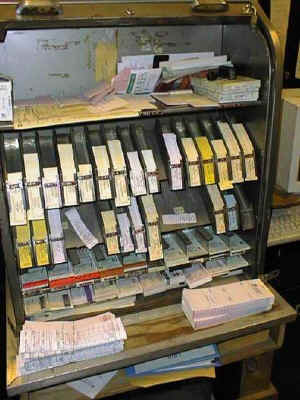|
LIRR ANECDOTES |
|
|
When I was at Huntington one evening, late 1990's, a conductor turned in a box at the ticket office. Opening the box, I saw that it contained about 200 wedding proof photographs.
It wasn't long before the phone rang. A woman who
sounded rather panicked, said "My husband left a box on the train."
I told her "We have it here."
That was a "Oh shit" moment for him, for sure, LOL. Yes, he offered money and was told no. And, he did write a letter.
Not too many people do that. Nice memories! Dave
Morrison |
|
|
One night (c. October 2011), while working KO (Ronkonkoma) second trick (2pm-10pm) as a TM (Transportation Manager), a Conductor brought a large bag into my office and said he found it in an overhead rack...he had opened it and it looked like some old strange tapes of some kind.
I did some sleuthing and found a name and phone number in the bottom of the bag and let the LIRR know first and then called the person and left a voice mail. Got a call back 5 minutes later from a panicked person, who said he lived about 20 miles away (further east). He had just gotten home and went to retrieve the bag only to find it missing...he was exhausted and totally blanked out, thinking he had it.
Drives back, comes into the office and opens the bag, breathes a sigh of relief and says, "do you know how much these tapes are worth???" I said no and he said it represented three years of work out in the jungle and other exotic locations...he was selling these original tapes (no copies existed) to National Geographic for $250,000.
He also tried to give me money, etc. but I praised
the Conductor who turned it in, and said we are all honest here and can't
accept any money...he wrote a letter. Robert L. Myers |
|
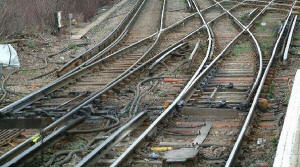 When the M-1s first came, many attempts were made at operating two car
trains. That didn't go well. For many years, four car units were regularly
run, but as the battery and motor-alternator conditions of the cars
deteriorated, brakes would sometimes apply (and wouldn't release) when the
units gapped, so four-car trains were eliminated. When the M-1s first came, many attempts were made at operating two car
trains. That didn't go well. For many years, four car units were regularly
run, but as the battery and motor-alternator conditions of the cars
deteriorated, brakes would sometimes apply (and wouldn't release) when the
units gapped, so four-car trains were eliminated.The MP-54's were very simple machines and any motorman/engineer could coast them through long gaps. The M-1/M-3 electrical systems tend to make brake applications when gapped if battery voltage isn't sufficient to maintain the release in control circuits. It's safe to say, though that a modern MU train in good condition is capable of coasting long distances also, but there are just too many variables in their complexities (motor/alternators, inverters, control circuitry, a/c pumps) involved to tolerate the risk. The Special Instructions can be found in any pre-1980 Timetable, if I remember correctly. I have never seen a photo of the gap jumpers, and I'm sure they are all gone by now, stolen for the copper. The Instruction warned engineers in M-1 equipment "not to exceed the P-1 power position" when using the jumpers. They were usually kept in red-painted wooden boxes at an interlocking, often lettered "Gap Jumper". The one I used was kept in the wooden box that was used to held rock salt for deicing walks and platforms in the snow. Not a very good place for a 600-volt cable. Now those boxes are made of Fiberglas and reside on station platforms, filled with bags of rock-salt. I think common sense won out and the gap jumper concept was quietly retired around 1982. Gap jumpers (snakes) were stored at many interlockings which were named in the Special Instructions. One particularly sorry set we were called to use was stored in the salt box at Valley. The asbestos insulation was crumbling off it as were the rotted and split wooden handles at each end. Or once, in Hall, a newspaper was stuffed to bridge a small gap between a third rail shoe and the third rail. A pail of water was thrown on it and with a smoky exploding flash from hell, it provided enough of a path to propel the cars a couple of feet back onto the rail. The Mechanical Department manager responsible for this pyrotechnic technological feat was, for the remaining 30 years, known to everyone as "Flash". As we used to say, "That's railroading" Info: A former LIRR Trainmaster. |
|
|
My first day as an L.I. Employee January 24, 1944, I was sent to the Bay
Ridge Yard to break in as a Switchtender. There was a period of about two
weeks of daylight hours to get to know the track layout, practice getting
on and off moving equipment, climbing ladders, walking catwalks while in
motion, applying various kinds of handbrakes, a knowledge of hand and
lantern signals and operating rules and a constant awareness that there
was an 11,000 volt catenary about three feet above when you were on a
boxcar and lower in some places where you had to duck down. Bay Ridge at the time was a beehive of activity, a bridge route from the south and west to New England via the PRR Greenville, New Jersey, to Bay Ridge car floats. There were four drill crews around the clock plus extras, all powered by pairs of LIRR B-3 0-6-0 electrics 324-327. The New Haven moved the trains with its class EF-1 2-4-4-2 electrics **O73-0111 usually in three or four unit lashups or one of the huge EF-3 4-6-6-4 **O150-0159. However, when an EF-3 had a heavy train, a pair of B-3’s pushed to about Sixth Avenue where they were cut off on the fly. The practice at Bay Ridge was for the B-3’s to pull the string of cars up Second Avenue where they could be switched to any of the 24 tracks in the yard. The conductor would tell the brakeman what track he would be headed for and how many cuts of cars he should wait for before riding them all the way in. This particular rainy night I rode the first car of three cuts headed towards “Benny” yard and stopped it just to clear the ladder tracks to hold the second cut of two loaded hoppers. Then when the third cut coupled, I released the brake so that I would ride all four cars down the track and couple to the two cars that were in the track all the way down at the float bridge end. Well, the brake I had was an old ratchet type that had a great amount of slack in the chain and we had picked up momentum before I could get it all rewound. I realized we were going to couple up hard to the two cars that were in the track so I got up on the catwalk where I could do some fancy footwork when we hit. However, we still didn’t stop; the brakes on those two cars didn’t hold and I was rolling towards the water with six cars and no carfloat was in the bridge. I jumped down to the hopper car and it seemed like eternity as I wound that brake on another notch and yet another notch and we finally did stop less than a car length from the water. It was a harrowing experience to say the least. **In steam days the New Haven electrics and diesels all had an “O” before their number. Near the end of steam this was omitted and the few remaining steam with conflicting numbers were given “S” before the number. |
|
|
A "TELL-TALE" |
|
|
Jeff Skinner had a friend (a "rabbi" as they were once referred) on the
LIRR who got him hired on in 1917 as a summer extra trainman (age 17). As
Jeff used to say, "I came to the LIRR as summer help and stayed 48
summers." |
|
|
Tell-Tales:
For
many years tell-tales were important structures that could be found all
along railroad rights-of-way. Prior to the modern era of air and
pneumatic brakes a crewman known as a brakeman was required to scale the
tops of freight cars, while the train was at-speed or in motion, and
manually set the each car's braking system. Obviously, this practice was
not only tedious but also extremely dangerous making the position of
brakeman one of the most dangerous within the industry at that time. The
purpose of the tell-tale was to warn the man, who was usually predisposed
at the time and concentrating on the job at hand, that an impending
obstacle was imminent down the line. Thanks to the invention of the
airbrake the practice was ended and so has the need for tell-tales.
Interestingly, however, many of the structures could still be found along
railroad tracks for decades and even today you can still find a few here
and there; a historical reminder of the early years of the industry and
its dangers. Source: american-rails.com |
|
|
FREE CAB RIDES? |
|
|
1. I got to ride the Bridgehampton freight in
one of the newly-arrived IC hacks, now painted bright yello0w. I got on at
Patchogue and rode out to Bridgehampton. We switched the stinky duck
farm(s) in Eastport and stopped on a siding there to eat lunch (really? No
appetite after THAT stench). |
|
|
BEER BRIBES |
|
|
My father worked for Piel Brothers in East New
York. When he drove me (a teenager) around to various locations to take
photos (1966-67), he'd have some 6-packs in the trunk. When I tried to
gain access to the interior of interlocking towers, he'd use the beer to
bribe the block operator into letting me get some photos inside.
Dave Keller |
|
|
PLAYING CARDS |
|
|
|
|
|
BLUE STRIPPED HEAVYWEIGHTS - A COUPLE OF THOUGHTS FROM AN "OLD TIMER" |
|
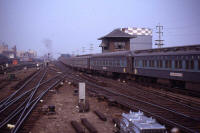 Re:
The zip cars. I was always amazed the cars
didn't buckle and derail with the weight of
an ALCO FA on the point and a C420 shoving
from behind. A few did, but overall, these
trains were successful. I imagine the
exchange on inertia through the car frames
was a "shock" to the car structures. Re:
The zip cars. I was always amazed the cars
didn't buckle and derail with the weight of
an ALCO FA on the point and a C420 shoving
from behind. A few did, but overall, these
trains were successful. I imagine the
exchange on inertia through the car frames
was a "shock" to the car structures.I hated the new paint scheme, except when it first came on line. Then it was a novelty, but I wish, wish, wish, the MTA had the courage to allow the LIRR to maintain the individuality it historically deserved. The original Parlor trains coming out of Jamaica, with 17 blue striped heavyweights, was a wonderful sight which I was fortunate to see and record. These cars were luxurious in a 1950's sense, with overstuffed swivel seats and bronze luggage racks. Standing at Nassau Tower on a Friday night, camera in hand, you could hear two ALCO c420's on the point and the rumble was a precursor. At high speed, they'd hit the crossing and the "chunk" of the weight on the rails was immediately followed by the baritone singing of six-wheel trucks in rapid succession. You had just enough time to snap your picture, wind the thumb lever, spin around and take in the train while you simultaneous looked over your should for the open-end observation car on the tail, and then a whirl wind of newspaper pages and dust. After that, you couldn't catch "The Cannonball" again, so you waited for the twin RS2's on the "Shelter Island Express". Great days for teenage railfans. Info: Richard Glueck |
|
| TICKET CASES | |
|
|
|
|
HOOPING ORDERS |
|
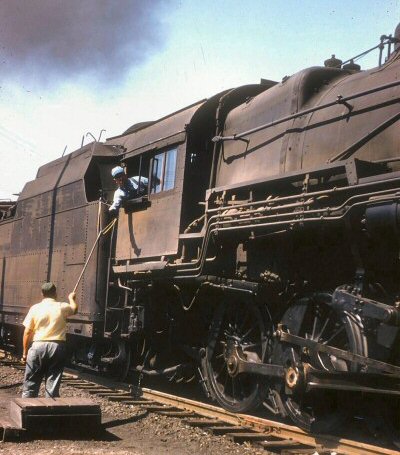 I
can give one story on myself for this. As a young extra agent covering
Mastic on the AM, I had to get orders ready for the westbound. As I am
writing and finishing up the orders and card, I hear a man telling someone
that I will have to go outside and give the papers to the engineer so he can
go further. When I look at the ticket window, I see the man and a young boy
about 7 years old. I
can give one story on myself for this. As a young extra agent covering
Mastic on the AM, I had to get orders ready for the westbound. As I am
writing and finishing up the orders and card, I hear a man telling someone
that I will have to go outside and give the papers to the engineer so he can
go further. When I look at the ticket window, I see the man and a young boy
about 7 years old.Now I decide I am going to be Joe Cool and do this right. I wave to him and tell them I have to close the window to go outside. I go through the whole thing of locking the ticket case, window, etc and wait for the engineer to acknowledge the order board. As I hear him, I lock up the office, really taking this too far, and go outside to hoop up the order and cards. As the the train gets closer, I see the engineer motioning that he wants both sets up on the engine. I get the sticks together and just as the engine gets to me, a gust of wind comes up and blows the orders off the sticks and down towards William Floyd Pkwy. I didn't tighten them too well. Now I have the engineer pissed at me since he has to wait for me to get the orders and the poor kid is standing on the platform while his father explains that this is not how it done. I could only laugh and shrug my shoulders. I never played Joe Cool again. Info: Kevin F. LIRR #113 H10s at DIVIDE Tower, Hicksville - Engineer Robert Creighton Photo/Archive: Art Huneke |
|
|
CAPTREE FISHING |
|
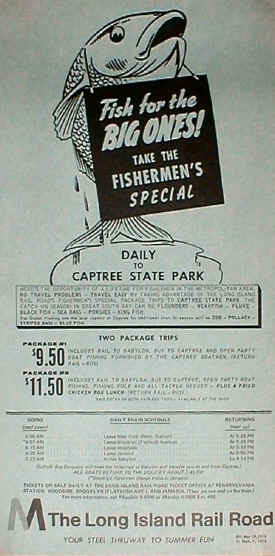 Home
to the largest public fishing fleet on Long Island, Captree State Park is a
fishing haven and a picnicker's delight, located on the eastern tip of Jones
Island at the end of the Ocean Parkway. Open and charter boats are available
for saltwater fishing. No license or equipment is necessary as the boat
staff provides everything you'll need for a day on the Great South Bay or
the Atlantic Ocean. Home
to the largest public fishing fleet on Long Island, Captree State Park is a
fishing haven and a picnicker's delight, located on the eastern tip of Jones
Island at the end of the Ocean Parkway. Open and charter boats are available
for saltwater fishing. No license or equipment is necessary as the boat
staff provides everything you'll need for a day on the Great South Bay or
the Atlantic Ocean.If you are unfamiliar with that Park, its main function is to serve as one of the largest places on the Island (save perhaps Montauk) to grab a "party" boat to go fish. Also a great spot for crabbing and fishing off a dock. Just watch the tide, it just whips through there except at slack water. The only way I could think of is that the LIRR offered a package to go to Babylon and then a bus to Captree. The Fish trains were once a big deal, a very early express train to go out East to drop off fishermen. A box car loaded with ice was provided for the trip home for the angler and his catch. Must have been a fun train for the CAMs (Car Appearance Maintainer = Coach Cleaner) to clean back in Richmond Hill. I didn't know they also made a stop at Canoe Place (seen from your page), that's great. Once a fantastic place for fish such as Winter Flounder and Weakfish (Sea Trout), and a easier walk than what you find at Montauk. I believe before the hurricane of 1938 (LI Express), the bulk of the fleet docked near the older station in the area called Navy Dock, so picking up the party boats was much easier then. Unfortunately, the fishing is a pale shadow of what it once was, but at the time it must have been great to have an express train take you out there and then a short walk to the fleet. Still some interesting fishing out there, including some great fresh water fishing a short walk away (don't mind the blue-green algae). The fleet now lies in present day Montauk Harbor near Gosman's and the main surf fishing is nearly 10 miles at the Point, so taking the train now isn't as attractive as it used to be. Unless you're sitting in the usual traffic on Rt. 27, which is almost enough at times to brave the Hipster parade and unruly teens from the Boardy Barn found today.
Fisherman's Special Fare Flyer - May 28th thru September 7th, 1970 |
|
|
LIST NHRS - FOILS A JAILBREAK |
|
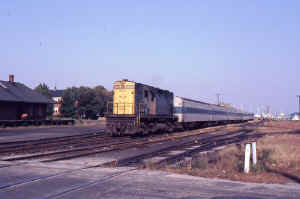 For
many years it was the practice of the Chapter to have an annual dinner; in
the fall of 1974 this event was held aboard the Sunday round trip train to
Greenport with a buffet style meal being served during the train’s layover
in Greenport station. Most of the Chapter members boarded the train at
Mineola; as was the practice at the time, member Gene Collora had organized
this trip. The usual consist of this train was one of the Alco 2000
horsepower road switchers with three P72 coaches. To provide for the Chapter
members, two of back to back observation cars were added to the east end of
the train with a former Boston and Maine coach converted to a bar car (used
for food service) between the Chapter’s reserved cars and the regular train
consist. The picture above shows the train in question standing in Greenport
station after the Chapter members attending had enjoyed their meal. Dinner
and layover time over; the train departed on its westbound run, the fall sun
having already dipped below the horizon. The train proceeded making all of
its scheduled local stops; the trip was uneventful as far as the Yaphank
station stop. Going west from Yaphank, the Long Island Rail Road climbs a
slight grade known as the ‘Yaphank Hill’; on the south side of the tracks is
a Suffolk County government complex which in 1974 included the county jail’s
farm. Our Alco Product's L1 began to accelerate hard out of the Yaphank
station stop in order to climb the hill. Suddenly the train had an emergency
brake application and came to a sudden stop. The jail’s farm herd of cows
had thought that the grass was greener on the other side of the fence and
had crossed onto the Long Island Rail Road right of way to feed. Suddenly
several of the cows came into the glow of the accelerating locomotive’s
headlight. As the locomotive came to a stop several of the cows were
deceased and others were mortally injured under the locomotive. The LIRR
Police was summoned to the scene and made attempts to euthanize the wounded
bovines with their .38 Police Special sidearms. The train was delayed at the
location for about two hours that evening as the line was cleared. Six cars
back in the rear observation, none of the Chapter members were injured in
the sudden stop; and up to that point it had been a great day out on the
line. By: Ed Koehler, Jr., Semaphore January 2017 For
many years it was the practice of the Chapter to have an annual dinner; in
the fall of 1974 this event was held aboard the Sunday round trip train to
Greenport with a buffet style meal being served during the train’s layover
in Greenport station. Most of the Chapter members boarded the train at
Mineola; as was the practice at the time, member Gene Collora had organized
this trip. The usual consist of this train was one of the Alco 2000
horsepower road switchers with three P72 coaches. To provide for the Chapter
members, two of back to back observation cars were added to the east end of
the train with a former Boston and Maine coach converted to a bar car (used
for food service) between the Chapter’s reserved cars and the regular train
consist. The picture above shows the train in question standing in Greenport
station after the Chapter members attending had enjoyed their meal. Dinner
and layover time over; the train departed on its westbound run, the fall sun
having already dipped below the horizon. The train proceeded making all of
its scheduled local stops; the trip was uneventful as far as the Yaphank
station stop. Going west from Yaphank, the Long Island Rail Road climbs a
slight grade known as the ‘Yaphank Hill’; on the south side of the tracks is
a Suffolk County government complex which in 1974 included the county jail’s
farm. Our Alco Product's L1 began to accelerate hard out of the Yaphank
station stop in order to climb the hill. Suddenly the train had an emergency
brake application and came to a sudden stop. The jail’s farm herd of cows
had thought that the grass was greener on the other side of the fence and
had crossed onto the Long Island Rail Road right of way to feed. Suddenly
several of the cows came into the glow of the accelerating locomotive’s
headlight. As the locomotive came to a stop several of the cows were
deceased and others were mortally injured under the locomotive. The LIRR
Police was summoned to the scene and made attempts to euthanize the wounded
bovines with their .38 Police Special sidearms. The train was delayed at the
location for about two hours that evening as the line was cleared. Six cars
back in the rear observation, none of the Chapter members were injured in
the sudden stop; and up to that point it had been a great day out on the
line. By: Ed Koehler, Jr., Semaphore January 2017
|
|
|
FBA - FLATBUSH AVE - YARD |
|
Now the space is totally enclosed and off-limits to all except the TA, so
don't expect to see anything. One thing that's interesting about how much
meat traffic there was at one time. Not only what went to EX yard but also
what was served on the ramp that went from Van yard up to the meat houses
that were on the ground level. At one time there was a nice old apple tree
about 2/3 up the ramp from where someone working that job tossed his apple
core. Again, all gone now... Anonymous |
|
.jpg)
%20-%2007-27-30%20(Sperr-Keller)%20(Zoom)_small.jpg)
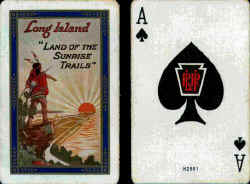
.jpg) Long
Beach Station - Ticket case 7/12/1972 Photo/Archive: Dave Keller
Long
Beach Station - Ticket case 7/12/1972 Photo/Archive: Dave Keller